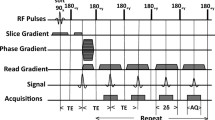Abstract
Accurate temperature and velocity measurement of fluid is of vital importance for CO2 Capture and Storage (CCS). The aims of this study were to evaluate the application of several magnetic resonance imaging (MRI) temperature measurement techniques in CCS and to simultaneously measure velocity and temperature distribution for flow field. First, the relations between MRI parameters including apparent self-diffusion coefficient (D), longitudinal relaxation time (T 1), longitudinal equilibrium magnetization (M 0) and temperature for three different samples were investigated. The results show that in high magnetic strength field the linear relationship between D and temperature is better than M 0–T and T 1–T in terms of accuracy and sensitivity. Then we used inversion recovery tagging method to simultaneously measure temperature and velocity of water flowing through a heated vessel. Temperature measured by IR-tagging method is within a deviation of 2 °C from the numerical results obtained by computational fluid dynamics.
Graphical Abstract









Similar content being viewed by others
References
Bloembergen N, Purcell EM, Pound RV (1948) Relaxation effects in nuclear magnetic resonance absorption. Phys Rev 73(7):679–712
Bottomley PA, Foster TH, Argersinger RE, Pfeifer LM (1984) A review of normal tissue hydrogen NMR relaxation times and relaxation mechanisms from 1–100 MHz: dependence on tissue type, NMR frequency, temperature, species, excision, and age. Med Phys 11(4):425–448
Deoni SC, Peters TM, Rutt BK (2005) High-resolution T1 and T2 mapping of the brain in a clinically acceptable time with DESPOT1 and DESPOT2. Magn Reson Med 53:237–241
Edward JT (1970) Molecular volumes and the Stokes-Einstein equation. J Chem Educ 47(4):261
Elkins CJ, Markl M, Iyengar A, Wicker R, Eaton JK (2004) Full-field velocity and temperature measurements using magnetic resonance imaging in turbulent complex internal flows. Int J Heat Fluid Flow 25(5):702–710
Fried MP, Morrison PR, Hushek SG, Kernahan GA, Jolesz FA (1996) Dynamic T1-weighted magnetic resonance imaging of interstitial laser photocoagulation in the liver: observations on in vivo temperature sensitivity. Lasers Surg Med 18(4):410–419
Fukushima E (1999) Nuclear magnetic resonance as a tool to study flow. Annu Rev Fluid Mech 31(1):95–123
Germain D, Chevallier P, Laurent A, Savart M, Wassef M, Saint-Jalmes H (2001) MR monitoring of laser-induced lesions of the liver in vivo in a low field open magnet: temperature mapping and lesion size prediction. Magn Reson Imaging 13:42–49
Hasegawa Y, Latour LL, Sotak CH, Dardzinski BJ, Fisher M (1994) Temperature dependent change of apparent diffusion coefficient of water in normal and ischemic brain of rats. J Cereb Blood Flow Metab 14:383–390
Imran J, Langevin F, Saint-Jalmes H (1999) Two-point method for T1 estimation with optimized gradient-echo sequence. Magn Reson Imaging 17(9):1347–1356
Ishihara Y, Calderon A, Watanabe H, Okamoto K, Suzuki Y, Kuroda K, Suzuki Y (1995) A precise and fast temperature mapping using water proton chemical shift. Magn Reson Med 34(6):814–823
Kuroda K, Suzuki Y, Ishihara Y, Okamoto K, Suzuki Y (1996) Temperature mapping using water proton chemical shift obtained with 3D MRSI: feasibility in vivo. Magn Reson Med 35(1):20–29
Kuroda K, Mulkern RV, Oshio K, Panych LP, Nakai T, Moriya T, Okuda S, Hynynen K, Jole FA (2000) Temperature mapping using the water proton chemical shift: self-referenced method with echo-planar spectroscopic imaging. Magn Reson Med 43(2):220–225
Le Bihan D, Delannoy J, Levin RL (1989) Temperature mapping with MR imaging of molecular diffusion: application to hyperthermia. Radiology 171(3):853–857
Lucas T, Musse M, Bornert M, Davenel A, Quellec Stéphane (2012) Temperature mapping in bread dough using SE and GE two-point mri methods: experimental and theoretical estimation of uncertainty. Magn Reson Imaging 30(3):431–445
Metz B, Davidson O, De Coninck H, Loos M, Meyer L (2005) Carbon dioxide capture and storage. IPCC Geneva, Switzerland
Moser E, Winklmayr E, Holzmller P, Krssak M (1995) Temperature and pH-dependence of proton relaxation rates in rat liver tissue. Magn Reson Imaging 13(3):429–440
Muller RN, Vander Elst L, Laurent S (2003) Spin transition molecular materials: intelligent contrast agents for magnetic resonance imaging. J Amer Chem Soc 125(27):8405–8407
Ogawa K, Tobo M, Iriguchi N, Hirai S, Okazaki K (2000) Simultaneous measurement of temperature and velocity maps by inversion recovery tagging method. Magn Reson Imaging 18:209–216
Parker Dennis L, Smith Vernon, Sheldon Philip, Crooks Lawrence E, Fussell Lauren (1983) Temperature distribution measurements in two-dimensional NMR imaging. Med Phys 10(3):321–325
Stephan Nekolla, Thomas Gneiting, Jutta Syha, Ralf Deichmann, Axel Haase (1992) T1 maps by K-space reduced snapshot-FLASH MRI. J Comput Assist Tomogr 16(2):327–332
Tsushima S, Hasegawa A, Suekane T, Hirai S, Tanaka Y, Nakasuji Y (2003) Velocity measurement of clay intrusion through a sudden contraction step using a tagging pulse sequence. Magn Reson Imaging 21(6):673–677
Waggoner RA, Fukushima E (1996) Velocity distribution of slow fluid flows in Bentheimer sandstone: an NMRI and propagator study. Magn Reson Imaging 14(9):1085–1091
Wlodarczyk W, Hentschel M, Wust P, Noeske R, Hosten N, Rinneberg H, Felix R (1999) Comparison of four magnetic resonance methods for mapping small temperature changes. Phys Med Biol 44(2):607
Xing D, Papadakis NG, Huang CLH, Lee VM, Carpenter TA (1997) Hall LD Optimised diffusion-weighting for measurement of apparent diffusion coefficient (ADC) in human brain. Magn Reson Imaging 15(7):771–784
Young IR, Hand JW, Oatridge A, Prior MV (1994) Modeling and observation of temperature changes in vivo using MRI. Magn Reson Med. 32(3):358–369
Zhivonitko VV, Koptyug IV, Sagdeev RZ (2007) Temperature changes visualization during chemical wave propagation. J Phys Chem A 111(20):4122–4124
Acknowledgments
This paper was financially supported by the National Natural Science Foundation of China (Grant Nos. 51506024, 51576032) and the Fundamental Research Funds for the Central Universities (DUT15TD26, DUT15TD27).
Author information
Authors and Affiliations
Corresponding authors
Rights and permissions
About this article
Cite this article
Jiang, L., Zhou, X., Liu, Y. et al. Noninvasive temperature and velocity mapping using magnetic resonance imaging. J Vis 19, 403–415 (2016). https://doi.org/10.1007/s12650-015-0326-6
Received:
Revised:
Accepted:
Published:
Issue Date:
DOI: https://doi.org/10.1007/s12650-015-0326-6




